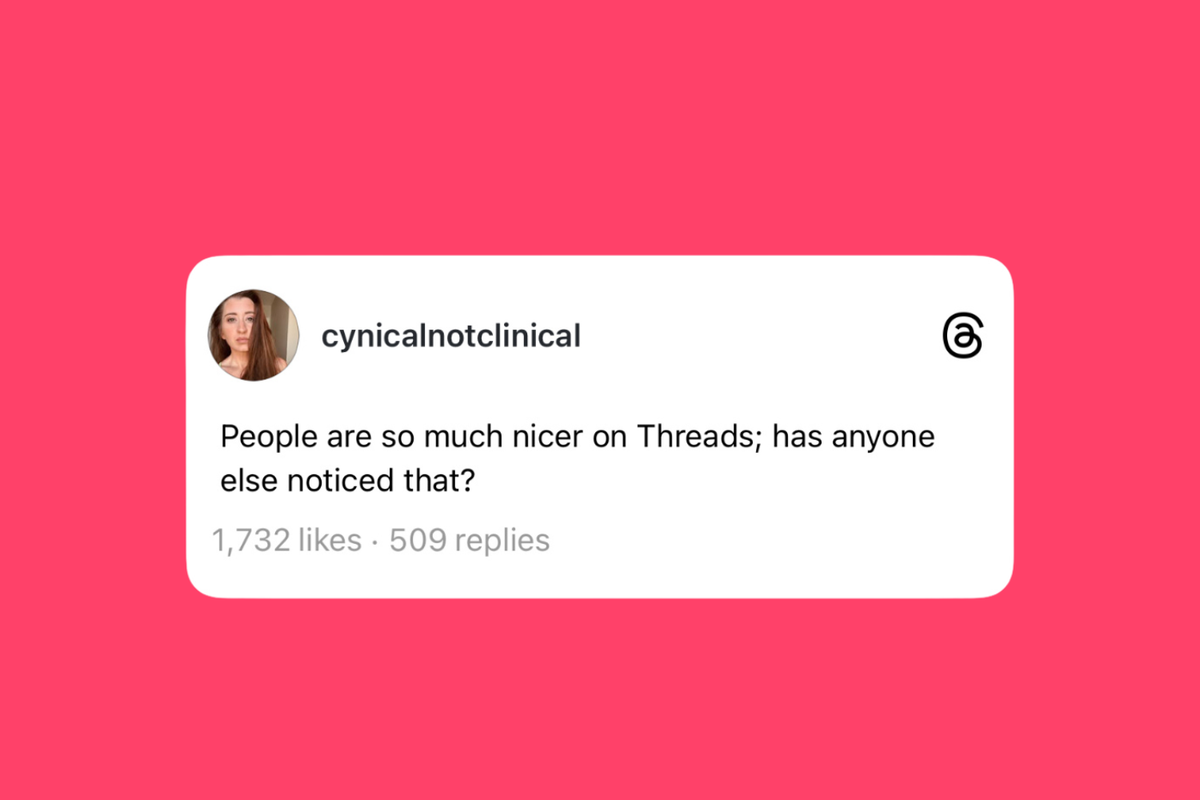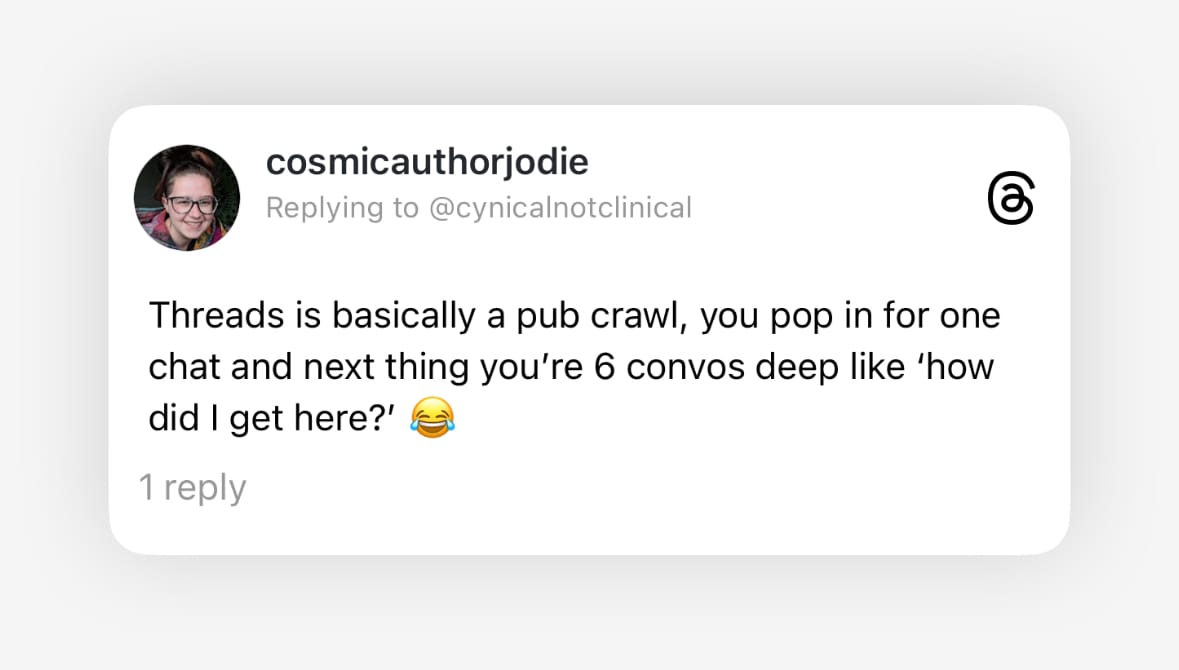The World is Nicer on Threads
How the platform works, the psychology behind, and tips for profile growth.

Social media has turned into one giant performance review.
Instagram wants your face. LinkedIn wants your resume. TikTok wants you to dance for dopamine. And Facebook wants you to fight with your uncle about politics.
Then there’s Threads, the one corner of the internet where it finally feels like you can just talk again without filters and SEO strategy and a pretty content calendar. You brain-dump whatever’s on your mind and people respond.
In one week of testing the thing, I pulled in 107,000+ views, 700+ followers, and 7,000+ interactions, which is more than I can say for the other algorithm graveyards.
What makes Threads different is that it doesn’t punish authenticity. It’s cleaner, less pressure, and weirdly therapeutic. It’s a space where you can rediscover your voice without wondering how it’ll look in Canva.

WTF is Threads
Threads launched in July 2023 as Meta’s “anti-Twitter.” Instead of building a totally new audience, it let users pull over their Instagram identity. That gave it instant community. Within five days, it hit 100 million sign-ups, and as of mid-2025, it’s sitting at over 400 million monthly users and still climbing.
But the real twist came when Threads started stepping into the Fediverse: a decentralized network of connected social platforms like Mastodon, WriteFreely, and BookWyrm. Basically, it’s the anti-algorithm corner of the web. If you enable “fediverse sharing” in your Threads settings, you can now see posts from other Fediverse users in a separate feed, follow them, and interact (with some limitations).
That connection between platforms means Threads users can start building bridges outside Meta’s walled garden. You’re no longer totally owned by one platform. For creators, that’s a big fucking deal.
It hints at a future where you can take your content, audience, and voice wherever you want.
Why Threads Feels Human
Threads works because it doesn’t make you perform for attention. There’s no pressure to curate or choreograph your personality for the algorithm; it just wants you to talk.
When you share something honest or a little messy, people lean in. That’s self-disclosure: you go first, they follow. Add in the mere exposure effect (aka: the more people see your name, the more they like you), and suddenly your voice feels familiar without you trying. It’s connection built from repetition, not perfection.
The one-reaction setup seals the deal. No fire emojis or passive-aggressive laugh reacts—just a simple “heart.” It’s clarity in a loud af world, and it keeps engagement feeling genuine. Mix that with conversation loops and a little social proof—comments spark comments, which spark reach—and you’ve got a feed that feels alive without turning into a circus.

When Threads Isn’t So Nice
Of course, not everyone’s experience is rainbows and friendly debate. I’ve seen plenty of people get the opposite: posts that go semi-viral for the wrong reasons, trolls swarming Taylor Swift comments (of course), or tone-deaf hot takes catching fire with the internet’s worst.
The same algorithm that rewards connection can also reward conflict. If you post something spicy, the engagement spike can pull in the assholes quick.
A few creators told me their most personal threads brought out armchair therapists and contrarians instead of connection. Meta’s filters do suppress some political or heavy content unless you follow those accounts directly, but that doesn’t stop negativity from leaking through. Still, Threads’ moderation team and block tools seem faster and cleaner than anything on X.
So Threads isn’t perfect, but it’s still miles better than the burnout factory of Instagram or the self-promotion Olympics of LinkedIn.
How to Grow Your Profile
If you want to test out the Threads community, sign up and start bitching about life. Watch what happens.
But if you’re running a business and want to make the most of it, start with your profile. That’s your storefront. Keep it tight, human, and clear. No jargon, no “growth hacker visionary thought leader” bullshit. Tell people who you are and what you talk about in plain English.
A good formula:
- Who you help + how you help them. (“Helping small biz owners make marketing suck less.”)
- Topic tags that sum up your interests. (“marketing,” “wellness,” “writing,” “design.”)
- A link that matters: your blog, product, or whatever you want people to click.
Then get posting. Ask questions. Share insights. Start mini rants. Jump into conversations like you’re replying to a group chat.
If you’re in it to grow, reply to people every day and post a few times a week. It’s not a grind; it’s a rhythm. You don’t need to act like a brand. But you do need to sound like a human who gives a shit.

Steal This ChatGPT Prompt
Have absolutely no idea where to start on Threads? Fine by me. Copy, paste, and personalize the ChatGPT prompt below, and it’ll hand you a full three-month strategy you can stick to without turning your personality into a brand deck.
Pretty intense prompt, right? Yeah well, the more you put in, the better output you get out.
🗯️ Shit to Think About
→ Are you showing up on social media to connect or to perform?
→ What if you stopped trying to “build an audience” and just started talking like a human?
→ If the internet is shifting toward smaller, human-first spaces like Threads, what does that mean for how you create, sell, and show up, and are you ready to build in a place that actually gives a shit?